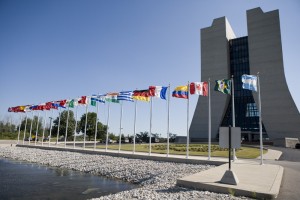The international diversity of Fermilab’s user community is growing.
Scientists and engineers from around the globe have flocked to Fermilab for years to use its resources in their pursuit of answers to the universe’s greatest mysteries. Today, Fermilab hosts users from 44 countries, more than ever before.
In 2015, Fermilab hosted a total of 3,564 users from 498 institutions. About 33 percent of these users hail from institutions outside of the United States. They come to Fermilab from six continents, a true testament to the universality of the language of science.
“It’s extremely healthy for the lab because it draws in really smart people from all over the world,” said Bill Louis, 2015-16 chair of the Fermilab Users Executive Committee and scientist from Los Alamos National Laboratory. “Having worked here on and off for the last 40 years, I think the present program is more exciting than ever.”
Most users continue to come from the United States and the United Kingdom. With 118 users from 37 institutions, Italy has the third-greatest number of users at Fermilab. India is a close fourth with 90 users from 19 institutions.
|
Countries with greatest participation in Fermilab user community |
||
| Country | Number of users | Number of institutions |
| United States | 2,386 | 206 |
| United Kingdom | 235 | 26 |
| Italy | 118 | 37 |
| India | 90 | 19 |
| Germany | 79 | 23 |
| Brazil | 73 | 14 |
| Russia | 73 | 10 |
| Switzerland | 58 | 7 |
| Japan | 57 | 15 |
| Canada | 49 | 13 |
| Spain | 46 | 16 |
| France | 44 | 14 |
| China | 33 | 7 |
| Korea | 31 | 12 |
| Mexico | 31 | 7 |
| Australia | 18 | 7 |
| Czech Republic | 18 | 3 |
| Colombia | 15 | 2 |
| Taiwan | 13 | 6 |
| Chile | 11 | 3 |
Fermilab plans to even more strongly engage the international neutrino science community as it seeks to host the LBNF/DUNE flagship project.
“The future of Fermilab is even more global than ever,” said Fermilab Chief Operating Officer Tim Meyer. “We’re working with partners around the world to plan, design and execute experiments that will change science textbooks.”
DUNE, the proposed Deep Underground Neutrino Experiment, will send neutrinos 800 miles through the earth from Fermilab to detectors in Lead, South Dakota, to learn more about these ghostly particles. With almost 800 collaborators from 145 institutions and 26 countries around the world, DUNE exemplifies the international effort that characterizes Fermilab’s user community and particle physics at large.
The Large Hadron Collider’s CMS detector at CERN is another example of the international diversity required to make big discoveries. The CMS collaboration has 4,300 active members from 42 countries and 182 institutions, including Fermilab.
“These days experiments are so big, like DUNE and the LHC, that you really need to draw in the whole world to work on them,” Louis said. “You need to bring in the world’s resources, ideas and talent.”
Scientists from around the world pulling together to learn more about the nature of neutrinos continues an already well-established practice in the particle physics community.
“The flagship effort in neutrinos builds on a long history of collaboration to launch the international Short Baseline Neutrino program and will culminate with LBNF/DUNE,” Meyer said. “Fermilab may do for neutrinos what CERN did for the Higgs!”
The nations represented in Fermilab’s user community are Argentina, Australia, Belgium, Brazil, Canada, Chile, China, Colombia, Cyprus, Czech Republic, Denmark, Ecuador, Egypt, Finland, France, Germany, Greece, Hungary, India, Ireland, Israel, Italy, Japan, Korea, Lithuania, Madagascar, Mexico, Paraguay, Peru, Poland, Russian Federation, Serbia, Slovakia, Slovenia, South Africa, Spain, Sweden, Taiwan, Thailand, Turkey, Ukraine, United Kingdom and the United States.




